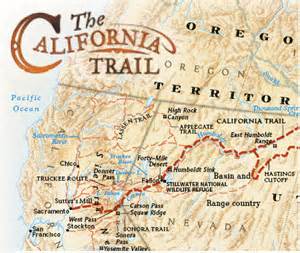The California Trail
The California Trail led thousands of would-be prospectors to the would-be promised land during the California Gold Rush. But the 2,000-mile trail from the Midwest to the Pacific Coast also carried a great many settlers looking for more and different opportunities. Gold was discovered in 1848. Before that, however, travelers were already on their way to California, through what is now Missouri, Iowa, Kansas, Nebraska, Wyoming, Idaho, Utah, and Nevada. The California Trail paralleled the Oregon Trail for a good bit of the way, then split to head a bit farther south. The California Trail had many variants, some of which crossed the rugged Carson Range and Sierra Nevada. Some of these routes were so well travelled that enterprising businessmen set up toll roads along the routes, charging travelers a small fee for taking what might be a shorter route to what might be a fortune. Once gold was discovered, the Carson Route became very popular because its endpoint was in the middle of the California gold fields.
Among the other well-known explorers to have travelled along the California Trail was John C. Fremont, who made multiple trips with dozens of others on horseback and ended up creating one of the more comprehensive maps of the California and Oregon areas. By 1844, wagon trains were making the journey. One of the more arduous of these was made by the Stephens-Townsesnd-Murphy Party, who got caught in early snow in the Sierras and had to abandon their wagons, coming back for them the following year. Perhaps the most famous group to travel along a version of the California Trail was the Donner Party, the ill-fated group who encountered horrendous weather Oxen pulled the majority of the wagons along the California Trail. Mules and horses did some of the work as well. Settlers used their wagons as temporary homes once they had arrived at their West Coast destination. travelers brought extra horse, oxen, and mules, as replacement draft animals, as well as cows and sheep, for meat. Dried vegetables and fruit were also common in travelers' supplies. As on other Trails West, the vast majority of travelers along the California Trail walked. Only the elderly, very young, pregnant, or injured rode for long in the wagons and then only for a short period of time: the wagons were a very bumpy ride! travelers bought cooking and foraging tools and, many times, guns for protection. They also brought roading tools such as shovels, mattocks, and hoes, to make the route more passable when needed. Enterprising travelers even turned a broken wagon wheel into an opportunity by cutting the wagon in half to make a two-wheeled cart. As with other Trails West, the California Trail fell into disuse after the advent of the Transcontinental Railroad. In all, more than 250,000 prospective farmers and prospectors made the journey to the Golden State in the early and mid-1850s. It was, in the minds of many historians, the largest mass migration in American history. |
|
Social Studies for Kids
copyright 2002–2026
David White



 A few pioneers of note explored the routes that became the California Trail, among them a party financed by Captain Benjamin Bonneville and led by explorer Joseph Walker. The more well-known Bartleson-Bidwell Party left Missouri with 69 people in May 1841 and made it, exhausted and starving, to California a few months later. A member of the Bartleson-Bidwell Party, Joseph Chiles, went back and became something of a tour guide, enlisting explorer Joseph Walker as a fellow guide and taking several groups of people back to California a couple of years later.
A few pioneers of note explored the routes that became the California Trail, among them a party financed by Captain Benjamin Bonneville and led by explorer Joseph Walker. The more well-known Bartleson-Bidwell Party left Missouri with 69 people in May 1841 and made it, exhausted and starving, to California a few months later. A member of the Bartleson-Bidwell Party, Joseph Chiles, went back and became something of a tour guide, enlisting explorer Joseph Walker as a fellow guide and taking several groups of people back to California a couple of years later.
